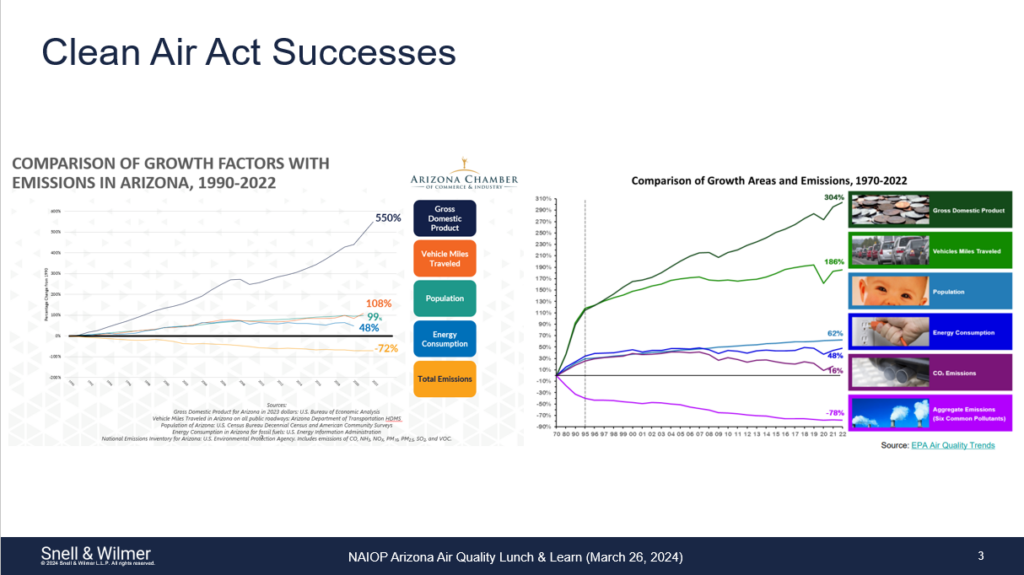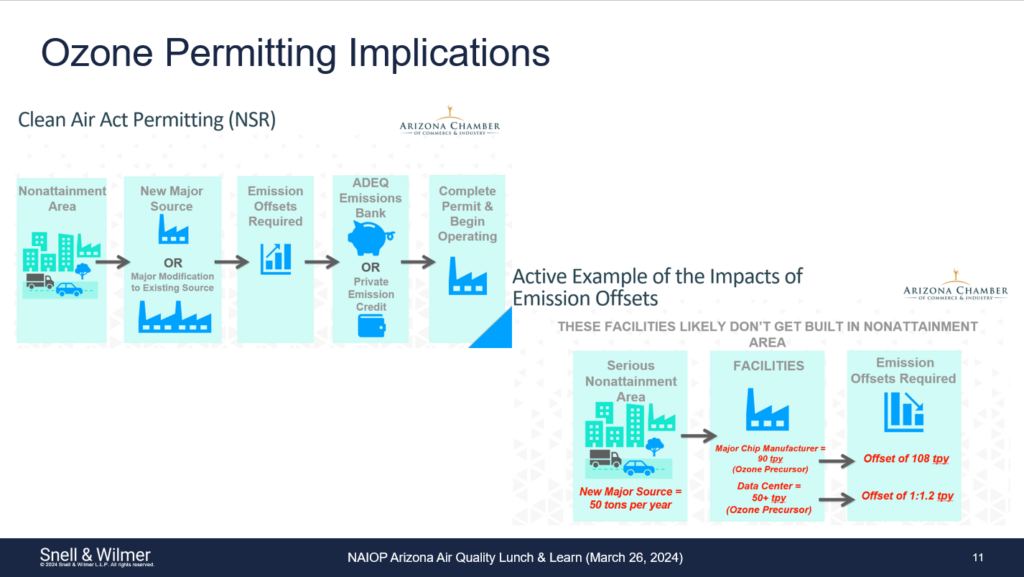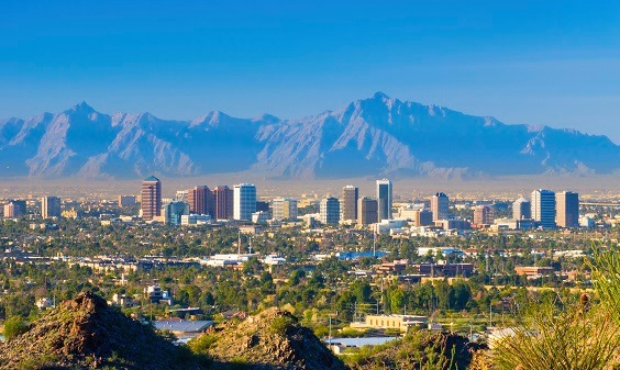By Rebekah Morris for AZBEX
Late last month NAIOP hosted a panel discussion regarding new air quality standards courtesy of the federal government that are sure to add a new space to your BINGO card for what may potentially kill a project.
The panel was moderated by John Baumer, NAIOP Arizona. Panelists were Amanda Reeve, Snell & Wilmer; Thomas Maynard, Greater Phoenix Economic Council; and Gary Bacon, Langan Engineering.
A final rule was issued by the EPA via the Federal Register on March 6 that has the effect of lowering the acceptable air quality standards for one of the six measured pollutants covered by the Clean Air Act of 1970.
Portions of Arizona have long been deemed as non-attainment zones for the current standards for Fine Particulate Matter, including PM2.5. PM2.5 particles have a diameter of 2.5 micrometers or smaller and have been a particular point of concern for Arizona. Lowering the acceptable thresholds will have the impact of sending Maricopa and parts of Pinal counties further out of compliance, triggering a new level of federal regulations and measures intended to bring the air quality into compliance.
Air quality has improved significantly since the Clean Air Act was introduced in 1970. According to EPA’s Air Quality Trends, since 1970 total emissions have decreased in the range of 72-78% while all measures of economic activity – GDP, vehicle miles driven, population, and energy consumption – have increased in that same time.

Federal One-Size-Fits-All Regulation Doesn’t Work in Ariz.
The topography and geography of the largest non-attainment zones in Arizona—Maricopa and Pinal counties—are such that pollutants just sit in the air. There is a tunnel effect bringing air pollution across borders and a bowl effect from the surrounding mountains creating a worst case scenario for air quality. In fact, 80% of emissions measured in Arizona are not produced or controlled by Arizona. The panel explained that most of the PM2.5 pollutants are caused by fire activities such as wildfires and fireworks.

Big Manufacturing Plants will go Elsewhere
The further out of attainment a region is deemed, the more stringent the measures are for obtaining new air quality permits. Air quality permits are required for companies considered “major emitters,” such as large manufacturing plants. If Maricopa County is pushed into a new level of non-attainment, the thresholds for who is required to get a new air quality permit is also tightened. According to Gary Bacon, “The timeline for a new air quality permit used to be six months, but now we’re seeing that stretch to 12-18 months.”
One reason Nikola Corporation built its manufacturing plant in Coolidge, rather than in Buckeye as originally planned, was to escape an air quality nonattainment zone and facilitate securing the needed air quality permit.
As more companies are deemed major emitters, they will be required to design with higher levels of air purification that will very likely force them to choose an easier place to locate. Maynard pointed out that driving manufacturing facilities overseas or across our borders pushes them into places with much lower air quality standards and will result in much higher levels of pollutants being produced.
“Don’t Sanction the Solution”
That quote has been attributed to Tim Franquist, who was the Director of the Arizona Department of Environmental Quality prior to being hired by the Arizona Chamber of Commerce and Industry. Ironically, many large manufacturers building plants in Maricopa County are in the desired industries of electric vehicles, battery manufacturing and other green technologies. To hinder green manufacturing facilities would hamper the long-term goal of moving to more green energy production and fewer gasoline powered cars on the roads. Tightened air quality standards would also work to derail the billions in ongoing and planned investment in Arizona’s advanced manufacturing economy.

One Lawsuit Already Filed; More to Come
Arizona State Senator Warren Peterson, along with the Arizona Chamber of Commerce and Business, has already filed a lawsuit to prevent the new lower PM2.5 limits from being enacted.
The Clean Air Act of 1970 was last amended in 1990. Reeve was quick to point out that manufacturing and business processes have changed dramatically since then, and the Act is in desperate need of amendments. However, the blanket adoption of standards without regard to background emissions and natural topography will hurt the ability to lure major employers like chip manufacturers that the state has worked so hard to attract.
Public Outreach Begins
Arizona Department of Environmental Quality expects to host a number of public information sessions and workshops about both the area designation process and then its initial boundary recommendations from spring 2024 through all 2024. ADEQ will then seek public input on its draft boundary recommendations through a formal public notice, comment period and hearing expected to occur by October 2024. ADEQ will submit its final boundary recommendations, including responses to public comments, to the Arizona Governor by January 2025 for review, approval and submission to EPA by Feb. 7. 2025.
EPA makes the final decision about which areas in Arizona, and the country, to designate as attainment, nonattainment or unclassifiable with respect to its new, more stringent, PM2.5 standard. EPA is expected to begin making its final area designations in 2026.
ADEQ encourages interested parties to get involved and sign up to receive information and updates about the boundary designation process, including meeting opportunities, by subscribing to ADEQ’s PM2.5 Boundary Designations email list here.

